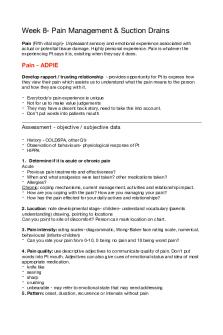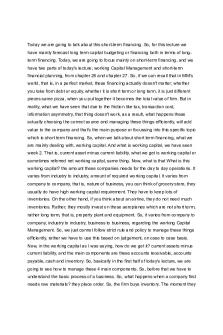Notes on Hourly Rounds 8 PDF

| Title | Notes on Hourly Rounds 8 |
|---|---|
| Course | Issues In Health Care And Professional Nursing |
| Institution | College of Staten Island CUNY |
| Pages | 3 |
| File Size | 61.9 KB |
| File Type | |
| Total Downloads | 67 |
| Total Views | 119 |
Summary
Download Notes on Hourly Rounds 8 PDF
Description
NOTES ON HOURLY ROUNDS 8/9/2016
Anticipating the Needs of the Patient by Implementing Hourly Rounding •
Press Ganey results have indicated a need for improvement in promptly responding to patients’ needs as measured by call bell response.
What if you could save 82 hours each week responding to call lights and deliver better clinical outcomes for patients? •
Hourly rounding is a best practice that reduces patient falls and skin breakdowns while improving patient satisfaction. The rounding protocol also drives more nursing care to the bedside, so nurses can be proactive instead of reactive with respect to workflow.
Hourly Rounding Gets Results: • • • •
Call Lights – decrease by 37.8% Patient Satisfaction – increase by 12 mean points Patient Falls – decrease by 50% Skin Breakdown – decrease by 14%
With Hourly Rounding We Can Accomplish: •
Improved customer satisfaction.
•
Decreased call bell usage
•
Improved employee satisfaction.
•
Increased referrals and repeat business.
•
Improved morale.
RUMC Problem Promptness response to Call Bell •
This score has been consistently low.
•
RUMC Hospital Press Ganey results have clearly demonstrated opportunity for improvement regarding response time to the nurse call bell.
Common Call Bell Issues
• • • • • • • • •
Bathroom/bedpan/urinal Pain Medication Information requests (tests discharge) Personal items not within patients’ reach IV/Pump alarm Dietary issues Call Bell not in my reach Assistance with positioning
What the Patients’ Expect Patients’ Expect: • • • • •
That there is staff available to meet their needs in a timely fashion Their concerns and requests are worthy of staff attention That repeat requests for the same need indicate staff not listening The staff to receive current information regarding their care All their needs will be met
What RUMC ‘s Goals ARE • • • • •
Proper staffing ratios and staggering of break times should be ensured by management Staff will treat every request with a sense of importance. Staff will eliminate many “first calls” by anticipating patients’ needs Staff will offer to patients realistic, achievable timeframes by which needs will be met In response to patient requests that cannot be met, staff should provide alternatives, rather than promising the undeliverable
Hourly Rounding CALL LIGHT PATIENT ROUNDING LOG • • • •
Rounding EVERY HOUR around the clock. Nursing assistants will round on the odd hours (7am, 9am, etc.) RN’s will round on the even hours (8am, 10am, etc.) NA’s and RN’s will document on the rounding log.
Proposed Behaviors to Eliminate Personal Needs Call Lights Hourly rounds: • • • •
Complete scheduled tasks Address 3 Ps: Potty, Position, Pain. Fluff pillows, fill water pitchers, straighten sheets Environmental assessment
Environmental Assessment
Any staff member can do this with training: • • • • • • •
Check for call light within reach Telephone within reach TV controls and bed light switch Bedside table next to bed Kleenex box Garbage can next to bed Is the patient properly covered and looking comfortable?
Eliminate Pain Management Call Lights • • •
RNs to put PRN pain medication on their list of scheduled things to do At the earliest frequency assess the patients pain level and offer the dose No patient should need to use the call light for pain medication requests
Staff member will tell patient, “I am here to do my rounds to check on your comfort.” • • • • • • • • •
Pain assessment Check if PRN medication is due Offer toileting assistance Assess patient comfort and positioning Check for call light, telephone, TV control and bed light switch being within reach Check for bedside table, Kleenex box and water being within reach Check for garbage can being next to bed Ask patient if they desire a refreshment Prior to leaving the room, ask patient: “Is there anything else I can do for you before I leave?”...
Similar Free PDFs

Notes on Hourly Rounds 8
- 3 Pages

Notes on Lecture 8 - London
- 7 Pages

Case Study 2 - Doha rounds
- 4 Pages

Worksheet Works Hourly Planner 2
- 1 Pages

8 - Lecture notes 8
- 21 Pages

8 - Lecture notes 8
- 21 Pages

Notes-on-nursing - notes on nursing
- 24 Pages

8 - notes
- 1 Pages

Notes on Law on Cooperative
- 20 Pages

8 Midwifery - Lecture notes 8
- 3 Pages

Taxation 8 - Lecture notes 8
- 2 Pages

Week 8 - Lecture notes 8
- 6 Pages

Dox 8 - Lecture notes 8
- 21 Pages
Popular Institutions
- Tinajero National High School - Annex
- Politeknik Caltex Riau
- Yokohama City University
- SGT University
- University of Al-Qadisiyah
- Divine Word College of Vigan
- Techniek College Rotterdam
- Universidade de Santiago
- Universiti Teknologi MARA Cawangan Johor Kampus Pasir Gudang
- Poltekkes Kemenkes Yogyakarta
- Baguio City National High School
- Colegio san marcos
- preparatoria uno
- Centro de Bachillerato Tecnológico Industrial y de Servicios No. 107
- Dalian Maritime University
- Quang Trung Secondary School
- Colegio Tecnológico en Informática
- Corporación Regional de Educación Superior
- Grupo CEDVA
- Dar Al Uloom University
- Centro de Estudios Preuniversitarios de la Universidad Nacional de Ingeniería
- 上智大学
- Aakash International School, Nuna Majara
- San Felipe Neri Catholic School
- Kang Chiao International School - New Taipei City
- Misamis Occidental National High School
- Institución Educativa Escuela Normal Juan Ladrilleros
- Kolehiyo ng Pantukan
- Batanes State College
- Instituto Continental
- Sekolah Menengah Kejuruan Kesehatan Kaltara (Tarakan)
- Colegio de La Inmaculada Concepcion - Cebu


